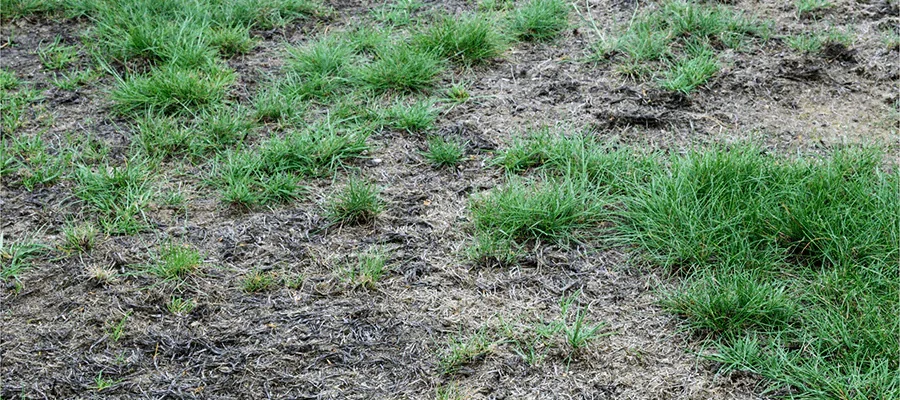Disease Control Services in the Indianapolis Area
For all your lawn care maintenance and service needs, contact Warweg & Co., Inc. today to schedule an appointment!
Expert Lawn Disease Control Services in the Indianapolis Area.
We control Central Indiana lawn disease – Warweg & Co., Inc. – (317) 885-8983

Lawn disease is not pretty. Homeowners in central Indiana rely on Warweg & Co. Irrigation to keep their lawns looking green and beautiful. Our professional and proven disease control methods and fungicide applications keep your grass healthy and green year-round.
Your lawn deserves more than surface-level care. Aeration & Seeding dives deeper, loosening compacted soil and giving fresh grass seed the space and nutrients it needs to grow into a stunning landscape.
Service Process
The mode of action for lawn disease is to advance rapidly. Prompt intervention by a professional lawn care team stops this progression before it eventually kills your grass.
Identification and Inspection
First, we identify the specific disease(s) your lawn has in order to choose an appropriate treatment. We also confirm that the problem is disease, not damage caused by pests (like grubs and chinch bugs).
After confirming the fungi or disease present, we analyze the conditions helping the disease thrive. This determines the areas to focus fungicide treatment. Our expert technicians look for:
Areas under stress from weather conditions, traffic patterns, etc.
Fertilization status
Evidence of pests
Treatment
We custom-mix a fungicide formulation to treat the specific fungi and diseases in your lawn. We spray broadly to drench blades and leaves. This ensures penetration of the cell membrane for lasting disease control.
Common Plant Diseases

Lawns have 500 to 1,000 individual plants per square foot. Lawn management includes water, fertilizer, light, proper mowing, and well-drained, aerated soil. If any factor is missing or out of balance, your lawn becomes more susceptible to disease. Common conditions include:
Ascochyta Spp.
Also known as Leaf Blight, this fungus creates heavily infested patches that form large bleached areas. Leaf blight occurs during hot weather, often caused by nighttime mowing and excessive watering.
Erysiphe Graminis
Better known as Powdery Mildew, this disease creates isolated colonies of fungus that infect large portions of grass with a whitish-gray, dusty powder. Areas with heavy shade are particularly susceptible.
Laetisaria Fuciformis
Often called Red Thread, this fungus consists of tiny red filaments projecting from the grass (usually Fescue species). Poor air circulation and drainage and layers of thatch encourage spread.
Marasmius Oreades
Also known as Fairy Ring, Elf Ring, and Pixie Ring, this condition appears as a circle of dark green, fast-growing grass surrounded by a dead, brown ring of grass. Spores spread Fairy Ring.
Monographella Nivalis
Also called Fusarium Patch or Snow Mold, this disease causes small, reddish-brown spots about one to two centimeters wide. This fungus prefers cool, wet weather and fine cold-season grasses.
Rhizoctonia Blight
This disease of warm and humid weather causes brown patches that expand to form a circle up to several feet in diameter. Soil fungi, insufficient sun, and insect damage cause rhizoctonia blight.
Puncciniales
Rust Disease appears as yellowy-orange flecks on grass blades, usually in late summer and fall when temperatures lower. Weather that changes frequently can also jumpstart disease spread.
Sclerotinia Homeocarpa
Also called Dollar Spot, this disease causes large tan wounds on grass blades that eventually form round, damaged patches the size of a silver dollar. A fungus that thrives between 60-90F causes Sclerotinia Homeocarpa.
Yellow Patch
Yellow Patch causes yellow, light brown, or reddish-brown circular patches in grass that can grow as wide as several feet. It tends to reappear from year to year if favorable conditions continue.
Everyone deserves a lawn they can be proud of. With our comprehensive lawn care services, your outdoor space will thrive season after season, no matter the challenges.
FAQ
How are fungicides applied?
Our lawn technicians spray the fungicide onto your grass and plants until blades and leaves are drenched and dripping. Some lawn diseases can develop fungicide resistance. Depending on the disease severity, we may have to re-apply at 7-to-14-day intervals to achieve complete disease control.
When do you apply fungicide to plants?
Your plants and lawn require preventative treatments whenever the climate becomes conducive to fungal development. Periods of excessive rain, high humidity, seasonal transitions, and an overabundance of nitrogen in the soil are all favorable conditions for growth. Whether preventative or to control active disease, fungicide treatments are most successful when applied in dry, cool weather.
What is the best time to spray fungicides?
Fungicides are more effective when applied during cool weather or, in warmer months, during the cooler morning hours. If temperatures reach 90F, we will come back at another time to complete the job.
For a free lawn analysis and disease control fungicide application estimate from our trusted professional lawn disease experts, call Warweg & Co., Inc. today at (317) 885-8983.
As we continue to grow, so do our service areas. And with each new location, we bring the same dedication to excellence that’s defined us since day one.

